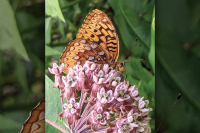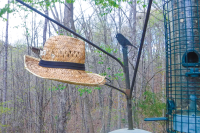Word from the Smokies: Scientific inquiry, a thriving enterprise in the Smokies
Birds, bees, bears, dragonflies, salamanders, hemlocks, fungi. Scientific research in Great Smoky Mountains National Park addresses a wide swath of subjects. From Tennessee, North Carolina, South Carolina and states much farther away, scientists from several disciplines have found the park fertile ground for inquiry.
State intends to spray Spongy Moth treatment over Haywood, Jackson
Residents of western Haywood County and eastern Jackson County will have the chance to learn about the Spongy Moth infestation that has hit several areas of the region, as well as what the N.C. Department of Agriculture plans on doing about the problem.
Burning bush has a high price
To the Editor:
A recent letter gave some very good advice: get outside and enjoy the outdoors. Nature has so much to offer when you experience it first-hand, up close and personal.
Moth brawl: A little moth is causing big problems in Cruso
Last week, more than a hundred people turned up to an informational meeting about a North Carolina Department of Agriculture plan to treat a small portion of Haywood County’s Cruso community for an invasive species of moth. And they weren’t happy.
Up Moses Creek: Moses Creek goes global
To my eyes it was as magnificent a tree as could be found in Western North Carolina — an eastern hemlock near Dismal Falls, on the flank of Big Pisgah Mountain.
Staying alive: MountainTrue protects A.T. ash trees as research progresses against invasive threat
For millions of years, ash trees have grown tall and strong across the landscape today known as the United States — but for now, keeping them alive requires regular treatment with expensive chemicals and $2,000 worth of specialized equipment.
Invasive mussels found in aquarium products
Invasive zebra mussels have been found in commercially available aquatic moss balls in North Carolina, and consumers who have purchased any such balls in the past month are urged to properly destroy them and clean their aquariums.
Fire (ants) on the mountain: Research shows invasives species can survive cold winters
Since its arrival to the United States in the early 1930s, the fire ant has been making a slow but steady march northward from the site of its initial arrival in Mobile, Alabama, but scientists had always assumed that cold winters would at some point put a stop to the tropical invasive species’ spread.
National parks battle invasion
The National Park Service is embarking on a system-wide effort to crack down on invasive animal species following the conclusion of a three-year research endeavor conducted by a panel of experts in fields ranging from park management to emerging technology.
The Park Service reached out to members of the group in 2016, asking them to review the agency’s existing approach to invasive animal management and to look at the results of data collected from park units across the country. Combining panel members’ expert knowledge with data results and information gleaned from questions to park staff, the group produced an internal report to the Park Service as well as a scientific paper published this month in the journal “Biological Invasions.”
From enemy to ally: Kudzu Camp seeks to overturn misconceptions
It was 1983 when Avram Friedman first rolled into Sylva, driving the repurposed school bus that was home for him, his wife and their 18-month-old son during their cross-country trek from California. They were looking for a more permanent living situation, and while most would have passed over the 3-acre property that is still the Friedman family home, to Avram it was perfect — mainly because the land and the house combined cost only $12,000.
“We didn’t have any money,” Avram laughed. “We were just poor hippies.”









